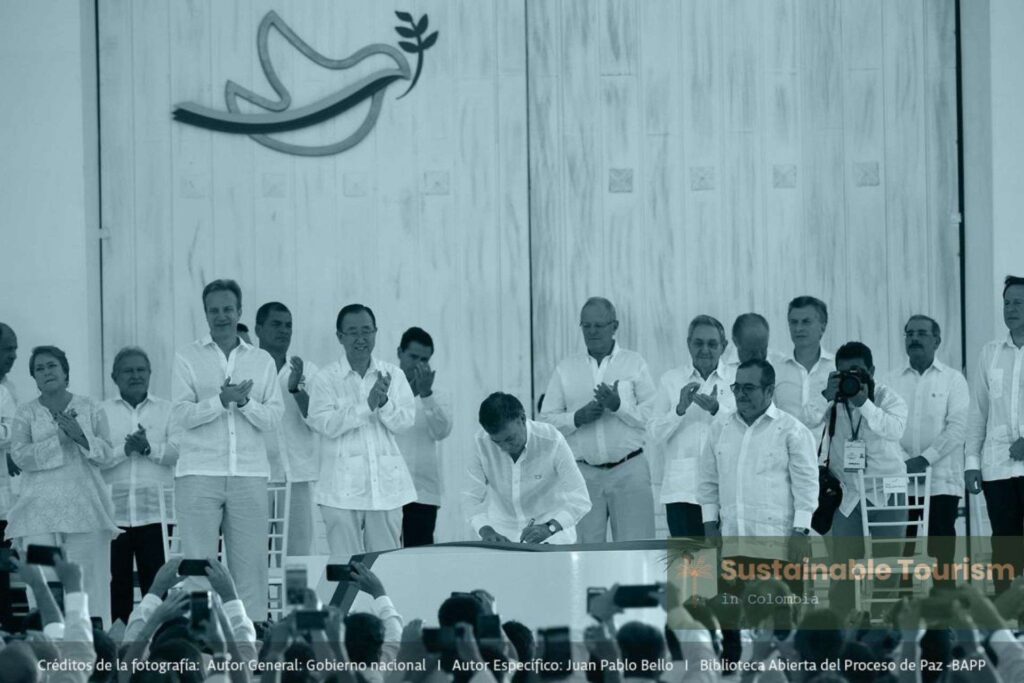For more than 50 years, Colombia faced an internal armed conflict that impacted its communities, economy, and international reputation. However, on November 24, 2016, the country took a historic step towards peace with the signing of the Peace Agreement between the Colombian government and the Revolutionary Armed Forces of Colombia (FARC).
This agreement marked a turning point, leading to greater security, economic growth, and the development of sustainable tourism projects in formerly affected regions.

Table of Contents
ToggleObjectives of the Peace Agreement
The 2016 Peace Accord aimed to bring long-term stability to Colombia through several key objectives:
✅ Ending armed conflict and integrating former combatants into civilian life.
✅ Developing rural areas by improving infrastructure, education, and economic opportunities.
✅ Supporting victims through truth, justice, and reparations.
✅ Strengthening democracy by increasing political participation and social inclusion.
✅ Reducing illicit drug production by promoting alternative, sustainable economic activities.
This agreement not only redefined Colombia’s future but also opened new doors for tourism and economic growth in previously inaccessible regions.
Implementation of the Peace Agreement
Since the signing of the accord, the Colombian government, along with international organizations and local communities, has worked towards the implementation of peace initiatives. These include:
🔹 Reintegration Programs – Over 13,000 ex-combatants have joined programs that provide education, employment, and entrepreneurship opportunities.
🔹 Rural Development – Investment in infrastructure, agriculture, and sustainable projects has improved living conditions in remote areas.
🔹 Security Improvements – The country has seen a significant reduction in armed conflict, making it safer for both locals and international visitors.
Despite challenges, Colombia continues to progress, ensuring that peace translates into long-term development.
Impact of the Peace Agreement on Tourism
One of the most notable results of the peace process is the rapid growth of tourism. With increased security and accessibility, more travelers are exploring destinations that were once off-limits.
🔹 Foreign tourism has increased by over 300% in the past decade.
🔹 Colombia has been recognized as a top travel destination by National Geographic, Lonely Planet, and other major publications.
🔹 New eco-tourism and cultural tourism projects have emerged in post-conflict areas.

Tourists can now experience the beauty and diversity of Colombia in places that were previously overshadowed by conflict.
Reintegration and Tourism: A New Opportunity
One of the most inspiring aspects of Colombia’s peace process is the role of former combatants in the tourism industry. Many have found new purpose by contributing to community-based tourism projects, including:
🌿 Guided nature tours in the Amazon and Pacific regions.
🏕️ Eco-lodges and sustainable accommodations managed by ex-combatants.
🎭 Cultural tourism experiences, where visitors can learn about Colombia’s history, resilience, and peacebuilding efforts.
Regions such as Caquetá, Guaviare, and Meta now offer unique tourism experiences, allowing travelers to support local communities while discovering hidden gems of Colombia.

Why Visit Colombia Now?
Colombia’s transformation is an example of resilience and progress. The country is now safer, more welcoming, and filled with authentic travel experiences that promote sustainable development and social inclusion.
📍 Plan your trip with SustainableTourismColombia.org and be part of Colombia’s new era of peace, security, and sustainable tourism.
Read more!
We have amazing places to let you know, read more about beauty Colombia!
- Unveiling Colombia’s Hidden Gems: Off the Beaten Path Destinations for Unforgettable Experiences – Part 2
- Exploring Colombia’s National Natural Parks: A Paradise of Biodiversity
- Bambuco, a traditional music genre
- The History of Arepa: Colombia’s Most Beloved Culinary Treasure


Recent Comments